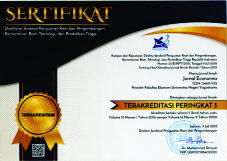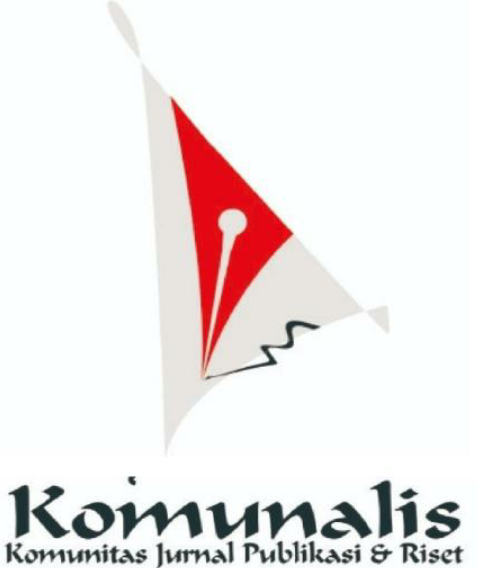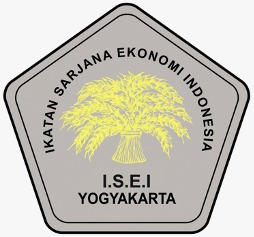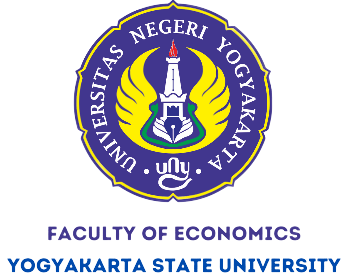The Role of Arisan in Alleviating Household Asset Poverty in Indonesia
Downloads
This study explored the impact of participation in Rotating Savings and Credit Associations (ROSCAs) on household asset poverty in Indonesia. It used secondary data from the Indonesia Family Life Survey (IFLS) waves 4 and 5. Asset poverty was measured using indicators from the Socioeconomic Data Collection; households were considered asset poor if they failed to meet nine out of 14 indicators. The analysis applied panel logistic regression with a fixed effects model. The results showed that ROSCA participation significantly reduced the likelihood of asset poverty. These findings supported previous studies that emphasized the positive effect of ROSCAs in reducing expenditure poverty. The study provided empirical evidence of ROSCAs’ role in improving household economic resilience. It suggested that government and related institutions could support and encourage ROSCAs as part of broader poverty reduction and financial security strategies.
Downloads
Acquah, J. K., & Dahal, R. (2018). ROSCAs as Lenders of Last Resort after Financial Crises: Lessons from Indonesia. Journal of International Development, 30(7), 1223–1239. https://doi.org/10.1002/jid.3366
Ademola, A., Egbide, B. C., Adegboyegun, A., Eluyela Damilola, Falaye Adebanjo, & Ajayi Abiodun. (2020). Rotating and Savings Credit Associations (ROSCAS): A Veritable Tool for Enhancing the Performance of Micro and Small Enterprises in Nigeria. Asian Economic and Financial Review, 10(2), 189–199. https://doi.org/10.18488/journal.aefr.2020.102.189.199
Ajija, S. R., & Siddiqui, A. I. (2021). Impact of Joining Rotating Savings and Credit Associations (ROSCAs) on Household Assets in Indonesia. The Journal of Developing Areas, 55(3), 205–216. https://doi.org/10.1353/jda.2021.0061
Ambec, S., & Treich, N. (2007). ROSCAs as Financial Agreements to Cope With Self-Control Problems. Journal of Development Economics, 82(1), 120–137. https://doi.org/10.1016/j.jdeveco.2005.09.005
Anderson, S., & Baland, J.-M. (2002). The Economics of Roscas and Intrahousehold Resource Allocation. The Quarterly Journal of Economics, 117(3), 963–995. https://www.jstor.org/stable/4132493
Anggraeni, L. (2009). Factors Influencing Participation and Credit Constraints of a Financial Self-Help Group in a Remote Rural Area: The case of ROSCA and ASCRA in Kemang Village West Java. Journal of Applied Sciences, 9(11), 2067–2077.
Banerjee, A., & Mullainathan, S. (2010). The Shape of Temptation: Implications for the Economic Lives of the Poor. NBER Working Paper Series. http://www.nber.org/papers/w15973
Bawani Satkunasingam, E., & Shanmugam, B. (2006). Underground Banking in Malaysia : a Case Study of ROSCAs. Journal of Money Laundering Control, 9(1), 99–111. https://doi.org/10.1108/13685200610645256
Benda, C. (2013). Community Rotating Savings and Credit Associations as an Agent of Well-Being: a Case Study From Northern Rwanda. Development Journal, 48(2), 232–247. https://doi.org/10.2307/26166088
BPS. (2022). Perhitungan dan Analisis Kemiskinan Makro Indonesia Tahun 2022.
Dagnelie, O., & Lemay-Boucher, P. (2012). ROSCA Participation in Benin: A Commitment Issue. Oxford Bulletin of Economics and Statistics, 74(2), 235–252. https://doi.org/10.1111/j.1468-0084.2011.00641.x
Donoso, S. B., Altunbas, Y., & Kara, A. (2011). The Rational Behind Informal Finance: Evidence From ROSCAs In Bolivia. The Journal of Developing Areas, 45, 191–208.
Gugerty, M. K. (2007). You Can’t Save Alone: Commitment in Rotating Savings and Credit Associations in Kenya. Economic Development and Cultural Change, 55(2), 251–282. https://doi.org/10.1086/508716
Gul, F., & Pesendorfer, W. (2001). Temptation and Self-Control. 69(6), 1403–1435.
Haughton, J., & Khanker, S. R. (2009). Handbook on Poverty and Inequality. The World Bank. https://documents.worldbank.org/en/publication/documents-reports/documentdetail/488081468157174849/handbook-on-poverty-and-inequality
Ibrahim, H. (2019). Do Institutions Matter?: The Persistence of ROSCAs Among Immigrants in Developed Economies. Journal of Enterprising Communities, 13(3), 319–332. https://doi.org/10.1108/JEC-04-2018-0027
Kharisma, B., Remi, S. S., Hadiyanto, F., & Dwi Saputra, A. (2020). The Economics of Rotating Savings and Credit Associations (ROSCAs) and Poverty in Indonesia. Jurnal Economia, 16(1), 100–111. https://doi.org/10.21831/economia.v16i1.30308
Kimuyu, P. K. (1999). Rotating Saving and Credit Associations in Rural East Africa. World Development, 27(7), 1299–1308. www.elsevier.com/locate/worlddev
Levenson, A. R., & Besley, T. (1996). The Anatomy of an Informal Financial Market: Rosca Participation in Taiwan. Journal of Development Economics, 51(1), 45–68. https://doi.org/10.1016/S0304-3878(96)00425-7
Maitra, P., Miller, R., & Sedai, A. (2023). Household Welfare Effects of ROSCAs. World Development, 169, 106287. https://doi.org/10.1016/J.WORLDDEV.2023.106287
Pambekti, G. T., Yusfiarto, R., & Nugraha, S. S. (2022). ROSCAs Through The Islamic Community: An Alternative To Enhancing Entrepreneurship And Wealth. Journal of Islamic Monetary Economics and Finance, 8(Special Issue), 81–106. https://doi.org/10.21098/jimf.v8i0.1371
Sadr, S. K. (2017). The Optimum Size of Rotating Qarḍ Hasan Savings and Credit Associations. ISRA International Journal of Islamic Finance, 9(1), 15–26. https://doi.org/10.1108/IJIF-07-2017-003
Shoaib, A., & Siddiqui, M. A. (2020). Why Do People Participate in ROSCA Saving Schemes? Findings From a Qualitative Empirical Study. DECISION 2020 47:2, 47(2), 177–189. https://doi.org/10.1007/S40622-020-00244-8
Tarmizi, E. (2012). Harta Haram Muamalat Kontemporer (L. Kartina, Ed.; 23rd ed.). P.T Berkat MuliaInsani.
Wapwera, S. D., Parsa, A., & Egbu, C. (2011). Financing Low Income Housing in Nigeria. Journal of Financial Management of Property and Construction, 16(3), 283–301. https://doi.org/10.1108/13664381111179242
Yandri, P., & Juanda, B. (2018). Memahami Karakter Kemiskinan Perkotaan dengan Pendekatan Observasional. Jurnal Ekonomi & Studi Pembangunan, 19(1). https://doi.org/10.18196/jesp.19.1.4276
Copyright (c) 2025 Jurnal Economia

This work is licensed under a Creative Commons Attribution 4.0 International License.















